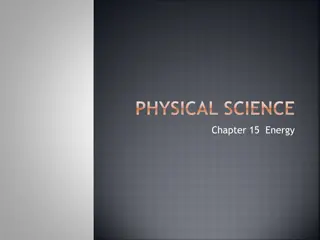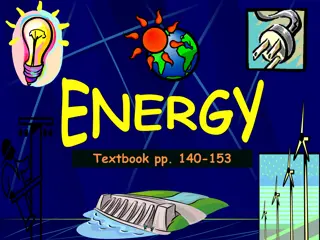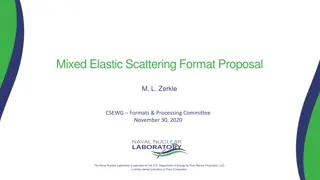
Elastic Strings and Springs Mechanics
Explore the energy storage and potential of elastic strings and springs when stretched or compressed. Delve into Hooke's law and the relation between force, extension, and work done in this insightful discussion. Uncover the misconception about the force-distance relationship during stretching.
Download Presentation

Please find below an Image/Link to download the presentation.
The content on the website is provided AS IS for your information and personal use only. It may not be sold, licensed, or shared on other websites without obtaining consent from the author. If you encounter any issues during the download, it is possible that the publisher has removed the file from their server.
You are allowed to download the files provided on this website for personal or commercial use, subject to the condition that they are used lawfully. All files are the property of their respective owners.
The content on the website is provided AS IS for your information and personal use only. It may not be sold, licensed, or shared on other websites without obtaining consent from the author.
E N D
Presentation Transcript
? =? ? Elastic Strings and Springs Spring being stretched You can find the energy stored in an elastic string or spring T F l x When a string/spring is compressed or stretched, it will ping back to its original length upon release Force applied (T) or ( x/l) This is the same as work done , and hence a compressed or stretched string/spring will have some potential energy ? ? Consider a graph showing the extension of a string against the force applied to extend it 0 0 ? Extension (x) The graph will be linear Consider Hooke s law The force applied to extend the string to length x is equal to the tension in the string (as tension will be opposing the force and the system will be in equilibrium) ? = ? ? Because l and are fixed values, double the extension will require double the force applied 3C
? =? ? Elastic Strings and Springs ? = ?? Force applied (T) or ( x/l) You can find the energy stored in an elastic string or spring ? ? Remember this formula from earlier mechanics modules? ???? ???? = ????? ???????? 0 ? = ?? 0 ? Extension (x) If the string has been stretched to a length x, the tension in the string will be x/l ? = ?? Sub in the force and distance stretched ? = ? ? ? Simplify ? = ?2 ? This is actually incorrect can you spot what is wrong? The issue is that the force increases gradually as the string stretches. It has not been x/l for the whole distance! 3C
? =? ? Elastic Strings and Springs ? = ?? Force applied (T) or ( x/l) You can find the energy stored in an elastic string or spring ? ? Remember this formula from earlier mechanics modules? Work Done ???? ???? = ????? ???????? 0 ? = ?? 0 ? Extension (x) As the force applied is increasing continuously as the extension does, that means the Work done also increases continuously The work done for the complete distance is given by the area under the curve (the triangle)! ???? ???? =1 2 ? ? ? Simplify ???? ???? = ?2 2? 3C
??? =?2 ? = ? ? 2? Elastic Strings and Springs ? = ?? Force applied (T) or ( x/l) You can find the energy stored in an elastic string or spring ? ? Remember this formula from earlier mechanics modules? Work Done ???? ???? = ????? ???????? 0 ? = ?? 0 ? Extension (x) ???? ???? = ?2 2? This is a formula for the work done in extending a string a given amount It will use the same amount of energy to ping back to its original length Therefore , this formula also represents the elastic potential energy of the string at that length! (Remember that this is relative to its natural length!) ??? = ?2 2? 3C
??? =?2 ? = ? ? 2? Elastic Strings and Springs ? = ?? Force applied (T) or ( x/l) You can find the energy stored in an elastic string or spring ? ? It is also possible to derive the formula for the area through Integration Work Done We will find the value of the integral of the line x/l between the limits x and 0 0 0 ? Extension (x) ? ? ? ?? Remember that and l are constants The integral will be taken with respect to x as this is on the x- axis 0 Raise the power of x by one and divide by the new power ? ?2 2? = Sub in the limits and subtract 0 (?)2 2? (0)2 2? = Simplify = ?2 2? 3C
??? =?2 ? = ? ? 2? Elastic Strings and Springs ? = ?? You can find the energy stored in an elastic string or spring ??? = ?2 2? Sub in values An elastic string has natural length 1.4m and modulus of elasticity 6N. Find the energy stored in the string when its length is increased to 1.6m. ??? =(6) 0.22 2(1.4) Calculate ??? = 0.0857? 3C
??? =?2 ? = ? ? 2? Elastic Strings and Springs ? = ?? You can find the energy stored in an elastic string or spring Use the new formula, x1 and x2 can represent the different extensions ???? ???? ???? 0.5? ?? 0.3? ???? ???? ???? 0.6? ?? 0.3? ???? ???? ???? 0.6? ?? 0.5? = A light elastic spring has a natural length 0.6m and modulus of elasticity 10N. Find the work done when the spring is compressed from a length of 0.5m to a length of 0.3m. 2 2 ?1 2? ?2 2? ???? ???? ???? 0.5? ?? 0.3? = Sub in values (10) 0.32 2(0.6) (10) 0.12 2(0.6) ???? ???? ???? 0.5? ?? 0.3? = Calculate parts (or do as a whole) 3 4 1 12 ???? ???? ???? 0.5? ?? 0.3? For this question you need to work out the difference between compressing the spring to 0.3m and compressing it to 0.5m = Calculate/Simplify 2 3? ???? ???? ???? 0.5? ?? 0.3? = This is because our formula gives us the work done in extending/compressing from the natural length 3C
??? =?2 ? = ? ? 2? Elastic Strings and Springs ? = ?? You can find the energy stored in an elastic string or spring Use the new formula, x1 and x2 can represent the different extensions ???? ???? ???? 0.4? ?? 0.2? ???? ???? ???? 0.6? ?? 0.2? ???? ???? ???? 0.6? ?? 0.4? = A light elastic spring has a natural length 0.6m and modulus of elasticity 10N. Find the work done when the spring is compressed from a length of 0.5m to a length of 0.3m. 2 2 ?1 2? ?2 2? ???? ???? ???? 0.4? ?? 0.2? = Sub in values (10) 0.42 2(0.6) (10) 0.22 2(0.6) ???? ???? ???? 0.4? ?? 0.2? = Calculate parts (or do as a whole) 4 3 1 ???? ???? ???? 0.4? ?? 0.2? We just worked out that it would 2/3J of energy to compress this spring from a length of 0.5m to a length of 0.3m = 3 Calculate/Simplify ???? ???? ???? 0.4? ?? 0.2? = 1? Why does it take more energy, even though the distance is the same? How much would it take to compress it from 0.4m to 0.2m? (The same distance ) It becomes increasingly hard to compress the spring as it gets shorter Imagine a long jumper trying to improve his leap from 7.5m to 8m. Then a year later, trying to improve from 8m to 8.5m it is much more difficult! 3C






















